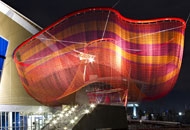Sky Garden looms over Vancouver 2010 Olympic Oval
Date uploaded: February 23, 2010
Water Sky Garden is a monumental immersive art environment that provides circulation and connectivity between the Olympic venue, the main road, and the waterfront. Visitors are welcomed along a curving red boardwalk. Above their heads suspend soft sculpture-nets that undulate in the wind and illuminate at night to become what the artist calls “sky lanterns”. The red footbridge leads visitors through a series of ponds featuring the artist’s “water drawing”, produced with streams of air bubbles that also remediate the quality of the run-off water that makes up the pond.
The artwork reflects the multi-layered cultural identity of the City of Richmond and the surrounding Vancouver region. The nearby Nitobe Japanese garden and the Sun Yat Sen Chinese garden were key references for the artist, in terms of their framing of views, material presence, and the shaping of pedestrian experience through paths and reflective ponds. The red cedar boardwalk follows a curving path modelled after the Chinese Dragon Dance, and the red “sky lanterns” refer the local Chinese festivals. Nets have a special relationship with the site, as the native Musqueam Band continue to teach their children to fish using nets at this particular bend in the Fraser River, and this area was historically home to a fishing and canning industry that employed many ethnic groups.
The 75 ft. diameter steel rings of the sky lanterns are suspended 50 ft. in the air from cables integrated into the structure of the building and landscape. The netting is machine-knotted and hand-baited from a custom twine of colorfast, 100% UV-resistant Gore™ Tenara® Architectural Fiber made of PTFE, the same material most commonly known as the non-stick pan coating Teflon®.
The environmental component of Water Sky Garden includes the recirculation of run-off water from the architecture’s 5-acre roof. The water is cleaned through aerating fountains and used to irrigate plantings. The water garden serves as a wetland treatment pond that provides storm water retention, water quality treatment, and water storage for irrigation use. 50% of the site is planted with native or adaptive species that absorb heavy metals, prevent siltation, and remove other impurities from water. They also provide a native habitat for birds, mammals and aquatic life, and recreate an authentic native wetland garden experience for visitors.


.jpg)
.jpg)
.jpg)
.jpg)
.jpg)
.jpg)
.jpg)
.jpg)
.jpg)
.jpg)
.jpg)
.jpg)
